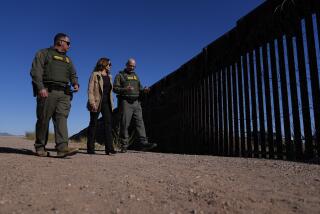Two Ends of the INS Enforcement Spectrum : Concern Grows Over Border Gangs
WASHINGTON — While reporting a six-year low in border apprehensions this year, U. S. immigration officials Friday expressed growing concern over gangs of Mexican youths who, after using drugs, attack U. S. agents by firing weapons and throwing rocks across the border.
Officials at the Immigration and Naturalization Service here said the incidents, most of which occur near San Diego and along the Texas border, have increased in the past two years, despite continued talks with Mexican officials.
“There is general agreement on both sides that these are problems we must deal with,” Commissioner Alan C. Nelson told a news conference. He said U. S. and Mexican officials most recently discussed the problems in July in a Washington meeting.
‘Complete Overreaction’
But Roberto Martinez, a Chicano rights activist in San Diego who monitors border issues, argued that the reported attacks against agents are being exaggerated--probably in an effort to justify the huge staff increases being in the Border Patrol, an INS enforcement arm.
“It looks like a complete overreaction and exaggeration,” said Martinez, who heads the U. S.-Mexico border program for the American Friends Service Committee, the social action arm of the Quaker Church.
INS officials said 34 firearm assaults against U.S. agents were reported in fiscal 1988, which ended Sept. 30, contrasted with 23 the previous year. As significant as the numbers, officials said, is the shift in the kinds of weapons used.
“They are more likely to be automatic firearms,” said Duke Austin, an INS spokesman. “Instead of a .22 pistol you get an AK-47,” a Soviet-made military rifle. “The types of weapons have heightened the concern over the increase in border violence.”
However, Robert Gilson, assistant chief patrol agent in San Diego, the single most active crossing point along the entire 1,952-mile border, said it has been three or four years since an agent in the sector was shot by a “bad guy.” One agent was mistakenly shot two years ago by another agent, Gilson said.
And Dana Cunningham, a Border Patrol spokesman in San Diego, could recall no incidents involving the use of AK-47s or other automatic weapons against agents in San Diego.
10 Aliens Shot Dead
But Martinez noted that more than 10 aliens have been shot dead and many others wounded in confrontations with Border Patrol and San Diego police units in the past two years.
“We consider many of these unjustifiable shootings,” Martinez said. “A lot of people were shot in the back.”
Border Patrol and police officials have defended the shootings.
Officials said no figures on rock-throwing incidents are available, but Nelson asserted that there have been many incidents in which gangs have “hit windshields and seriously injured people” with “baseball-size or softball-size rocks.”
In border areas, INS agents have been harshly criticized by rights groups for overreacting to such rock-throwing incidents. In the most celebrated case, a U. S. district judge in San Diego awarded a Tijuana teen-ager $574,000 last year for injuries suffered when he was shot in the back by a Border Patrol agent in April, 1985, as the boy stood in Mexican territory. The officer maintained that he acted properly against a rock-throwing barrage, but the judge ruled that the agent’s version of events was “incredible.”
Clarence M. Coster, associate commissioner for enforcement, said the attacking youths often sniff gasoline and glue before the attacks. Their behavior, he said, represents a “changing sociological pattern” near the border, where a sagging economy has cast many Mexicans into abject poverty.
Martinez said, “That’s hardly anything new.”
In talks with Mexican officials, INS officials have sought to improve radio communications and persuade the Mexicans to initiate quicker responses when U. S. border agents alert them to trouble.
The incidents are escalating even as the INS apprehends fewer Mexicans trying to cross the border into this country.
Nelson said the INS recorded arrests of 940,670 illegal aliens in fiscal 1988, the lowest total since fiscal 1982, when 750,000 were apprehended. The 1988 total represented a 16% drop from the previous year and was 42% lower than the number in 1986.
The commissioner attributed the decline to the 1986 immigration law, which sought to make it more difficult for illegal immigrants to find and keep employment in the United States. He also said the drought last summer and the absence of farm labor shortages contributed to the sharp drop in apprehensions.
However, academic researchers in San Diego and Tijuana have found that the new law is not substantially deterring migrants from attempting to enter the United States illegally. The decreased arrest numbers, researchers concluded, were not an accurate barometer of the law’s effectiveness.
Times staff writer Patrick McDonnell contributed to this story from San Diego.
More to Read
Sign up for Essential California
The most important California stories and recommendations in your inbox every morning.
You may occasionally receive promotional content from the Los Angeles Times.










